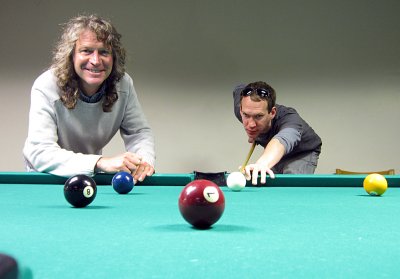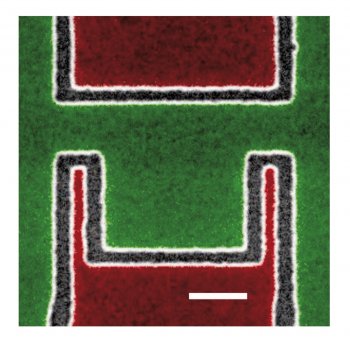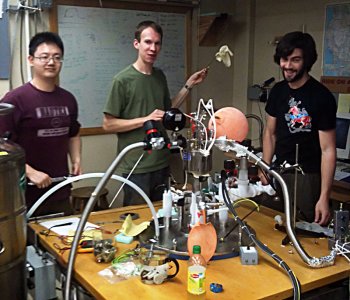EUGENE, Ore. — (May 14, 2012) — Tiny electrons moving along semiconductors and billiard balls on defective pool tables behave the same in the presence of unseen grooves or bumps. They easily are thrown off course, says an international team of physicists. In a paper published in Physical Review Letters, the 13-member team, which includes University of Oregon physicist Richard Taylor, report on experimental games of "semiconductor billiards." They studied electrons moving on a nanoscale pool table — in this case the semiconductor gallium arsenide. Such surfaces contain impurities from the manufacturing process, resulting in warping, a challenge that if eliminated could enhance the development of future computing technologies.
In a paper published in Physical Review Letters, the 13-member team, which includes University of Oregon physicist Richard Taylor, report on experimental games of "semiconductor billiards." They studied electrons moving on a nanoscale pool table — in this case the semiconductor gallium arsenide. Such surfaces contain impurities from the manufacturing process, resulting in warping, a challenge that if eliminated could enhance the development of future computing technologies.
Earlier studies assumed such warping was negligible, with the electron paths determined only by the semiconductor's shape — such as square, circular or stadium-shaped. "We found that we can 'reconfigure' the warping by warming the table up and cooling it down again, with the electron paths changing radically in response,” said Taylor, director of the UO Materials Science Institute. "This shows that the warping is much more important than expected." The research team also presented a redesign that allows the bumps to be ironed out. Researchers in the School of Physics at the University of New South Wales (UNSW) in Australia led the project, which assistance from Taylor and other collaborators from the Niels Bohr Institute at the University of Copenhagen in Denmark and from Cambridge University in the United Kingdom.
The research team also presented a redesign that allows the bumps to be ironed out. Researchers in the School of Physics at the University of New South Wales (UNSW) in Australia led the project, which assistance from Taylor and other collaborators from the Niels Bohr Institute at the University of Copenhagen in Denmark and from Cambridge University in the United Kingdom.
"Scaled down a million-fold from the local bar variety, these microscopic pool tables are cooled to just above absolute zero [-459 degrees Fahrenheit; -273 degrees Celsius] to study fundamental science — for example, how classical chaos theory works in the quantum mechanical limit, as well as questions with useful application, such as how the wave-like nature of the electron affects how transistors work," said Adam Micolich of UNSW and formerly a postdoctoral researcher at the UO. "In doing this, impurities and defects in the semiconductor present a serious challenge."
Ultra-clean materials are used to eliminate impurities causing backscattering, but until now there has been no way to avoid the ionized silicon atoms that supply the electrons, he said. "Their electrostatic effect is more subtle, essentially warping the table's surface." Using a new billiard design developed during physicist co-author Andrew M. See's doctoral work at UNSW, the silicon dopants are removed, eliminating the associated warping, and enabling the electron paths to stay the same each time they cool the device down for study.
Using a new billiard design developed during physicist co-author Andrew M. See's doctoral work at UNSW, the silicon dopants are removed, eliminating the associated warping, and enabling the electron paths to stay the same each time they cool the device down for study.
The improvement gained by removing the silicon was much greater than expected, based on earlier efforts. "But at the nanoscale, it seems the dopant atoms make a really big difference," Micolich said. "Ultimately, our work provides important insight into how to make better nanoscale electronic devices, ones where the properties are both more predictable and more consistent each time we use them."
The Australian Research Council, Office of Naval Research, U.S. Air Force, National Science Foundation, the Research Corporation and the UK Engineering and Physical Sciences Research Council supported the project.
The University of New South Wales also issued a news release on this research.
About the University of Oregon
The University of Oregon is among the 108 institutions chosen from 4,633 U.S. universities for top-tier designation of "Very High Research Activity" in the 2010 Carnegie Classification of Institutions of Higher Education. The UO also is one of two Pacific Northwest members of the Association of American Universities.
Media Contacts: Jim Barlow, director of science and research communications, 541-346-3481, jebarlow@uoregon.edu , or Robert Beale, 02 9385 2864, bbeale@unsw.edu.au (http://newsroom.unsw.edu.au/news-office/contact )
Sources: Adam Micolich, professor of physics, University of New South Wales, 02 9385 6132, adam.micolich@gmail.com ; and Richard Taylor, professor of physics, University of Oregon, 541-346-4741, rpt@uoregon.edu
UO Science on Facebook: http://www.facebook.com/UniversityOfOregonScience
Note: The University of Oregon is equipped with an on-campus television studio with satellite uplink capacity, and a radio studio with an ISDN phone line for broadcast-quality radio interviews. Call the UO Media Contact above to begin the process.